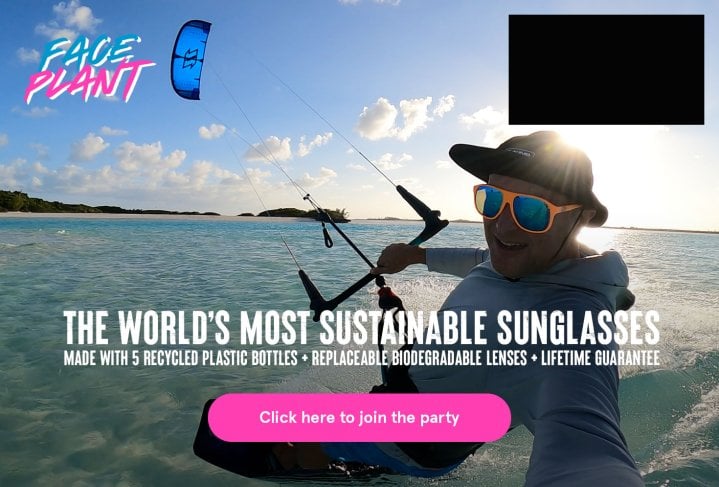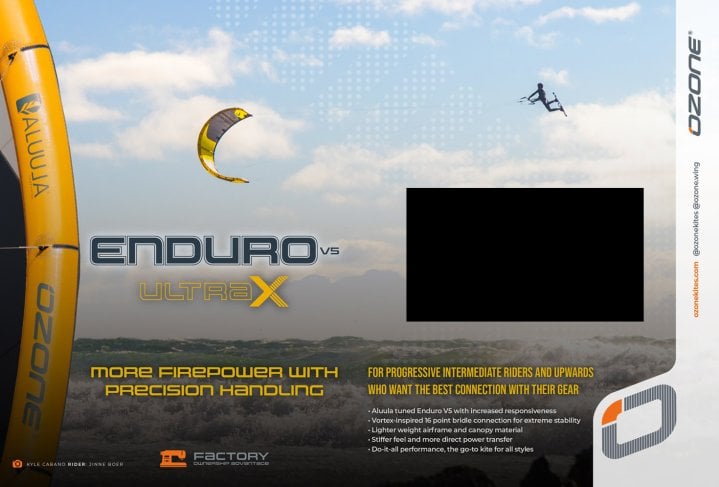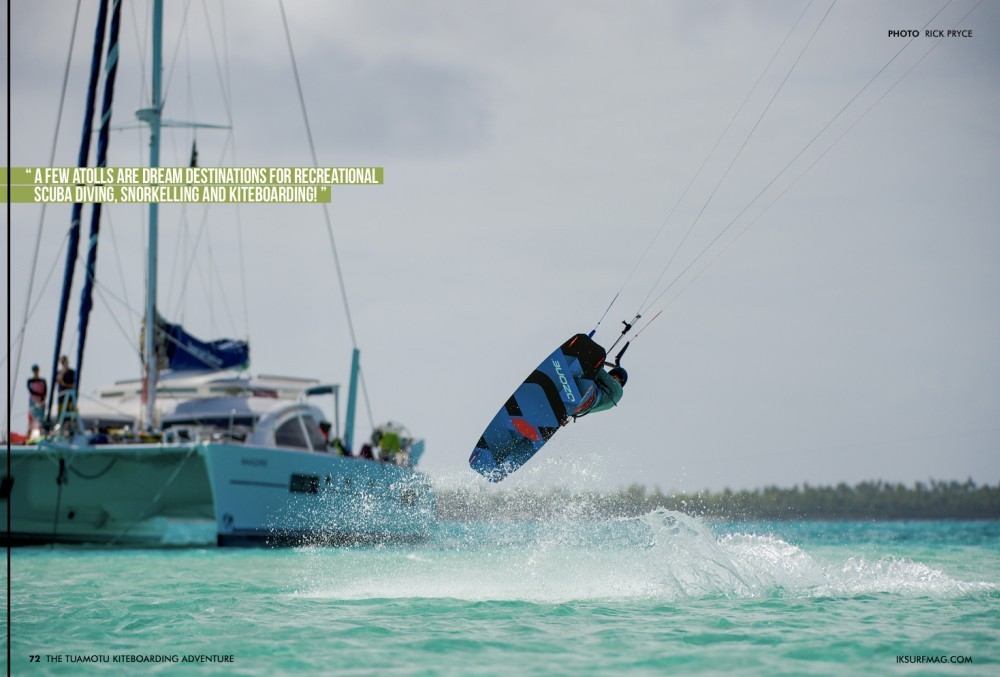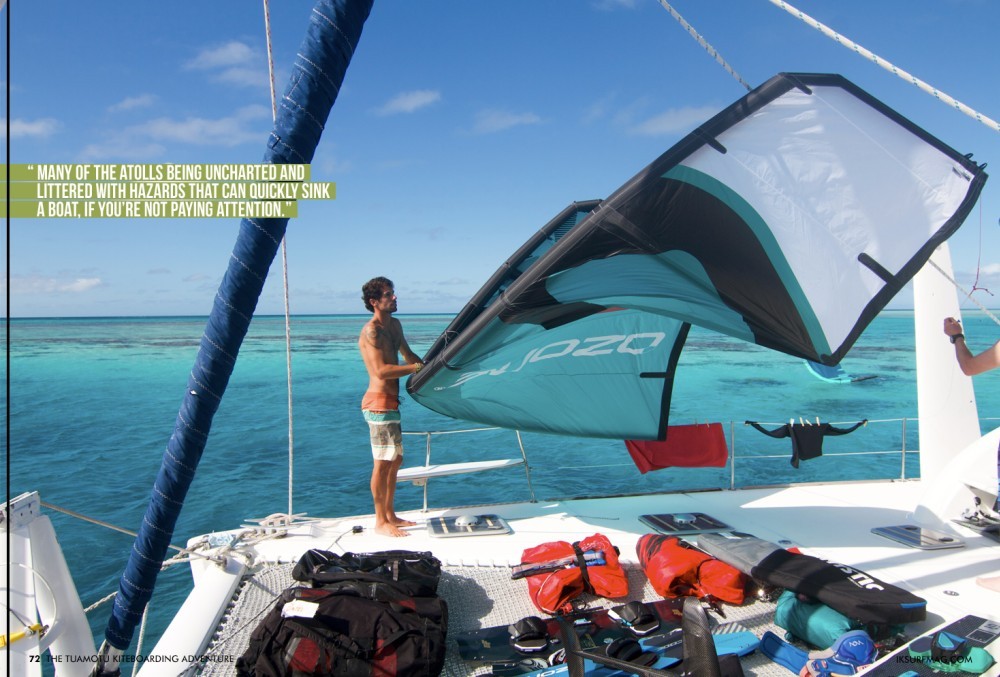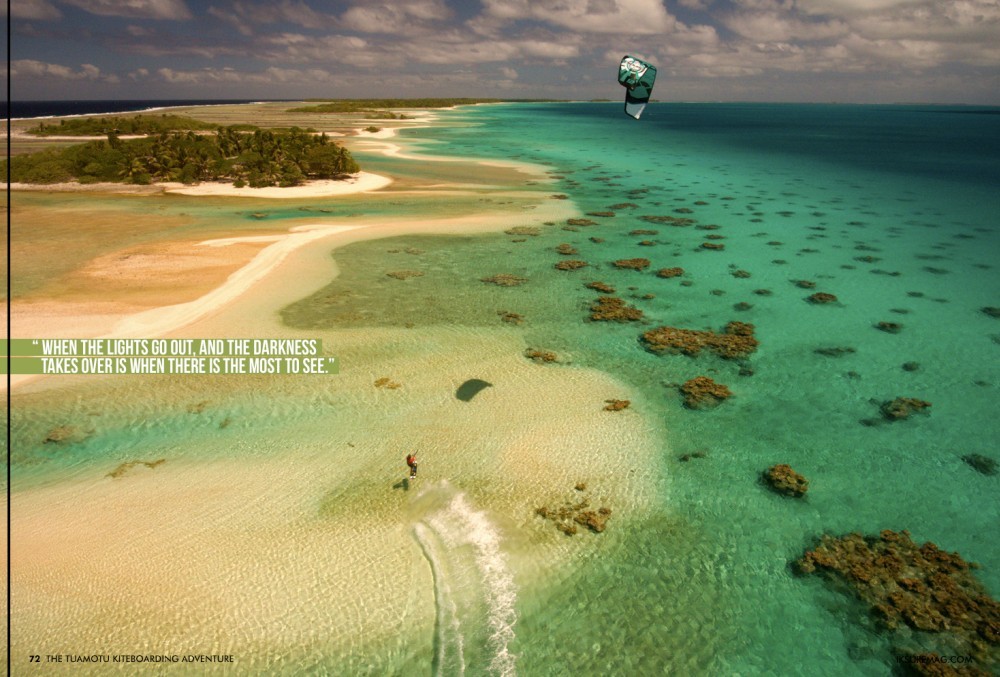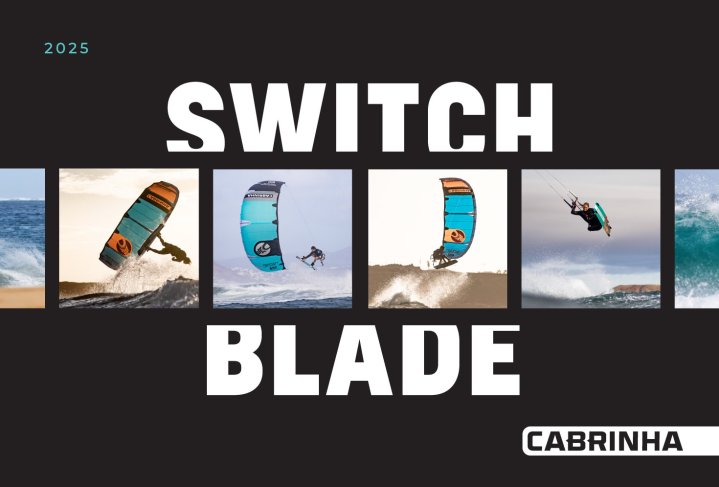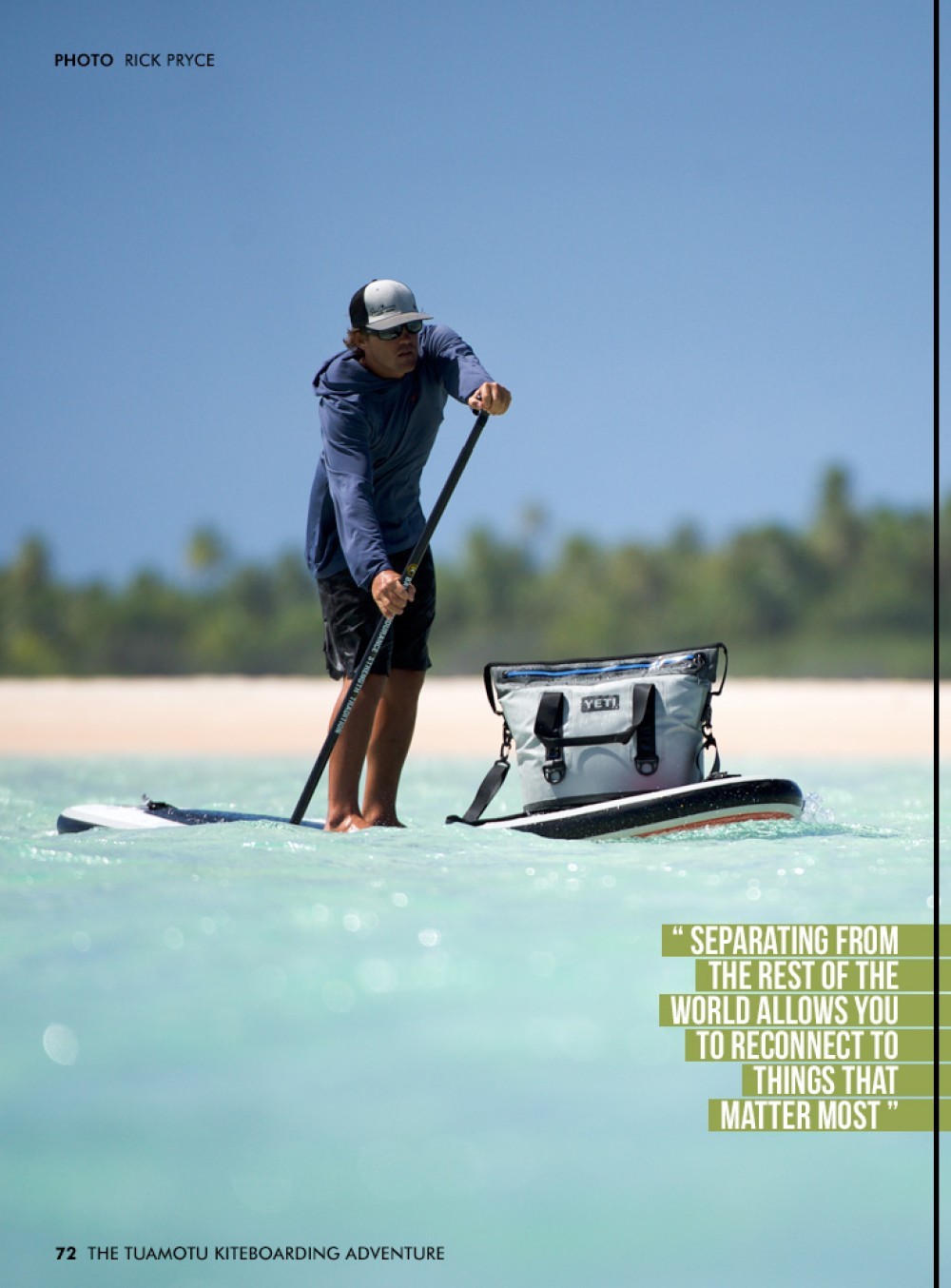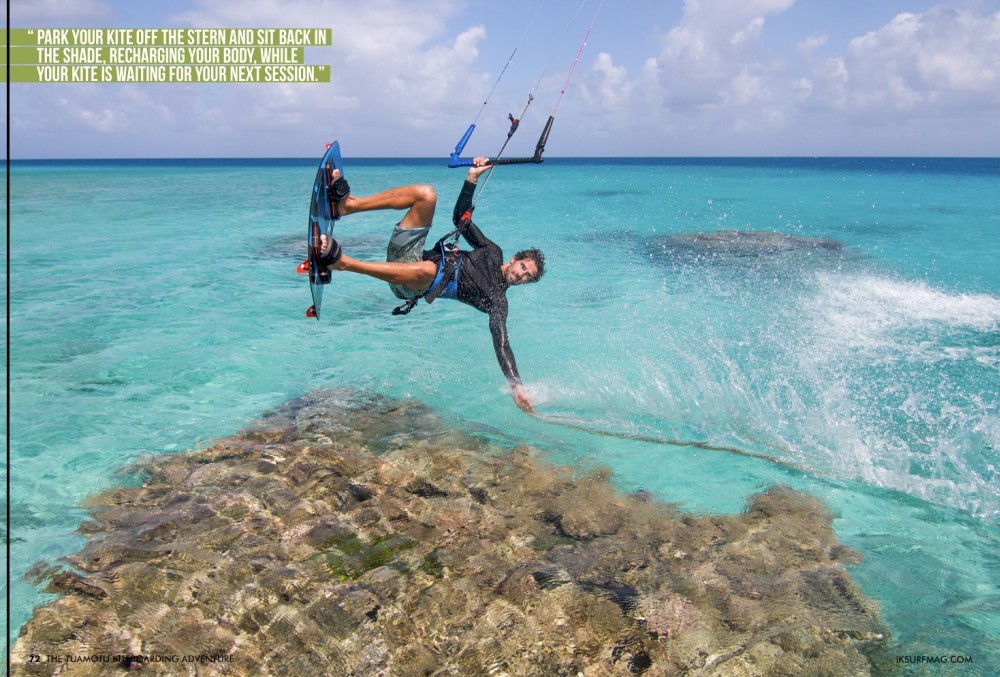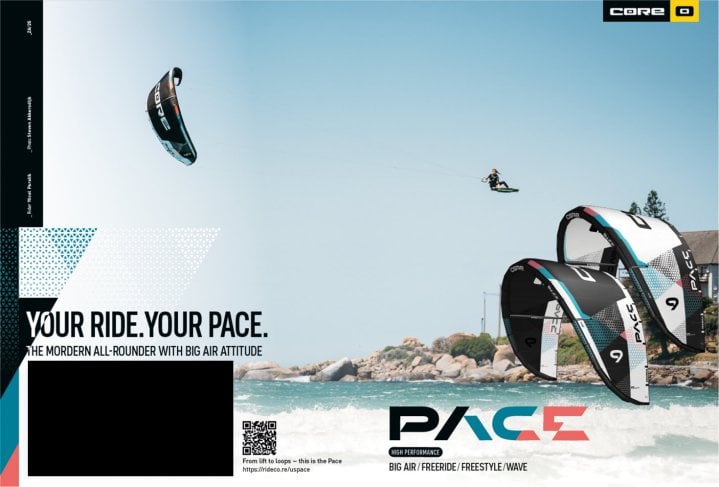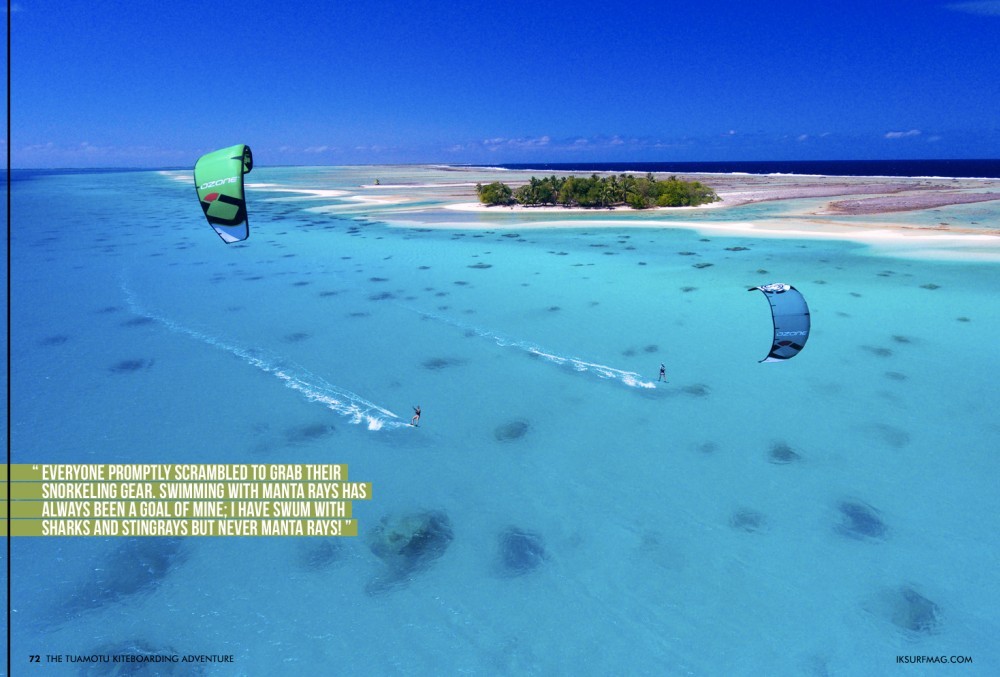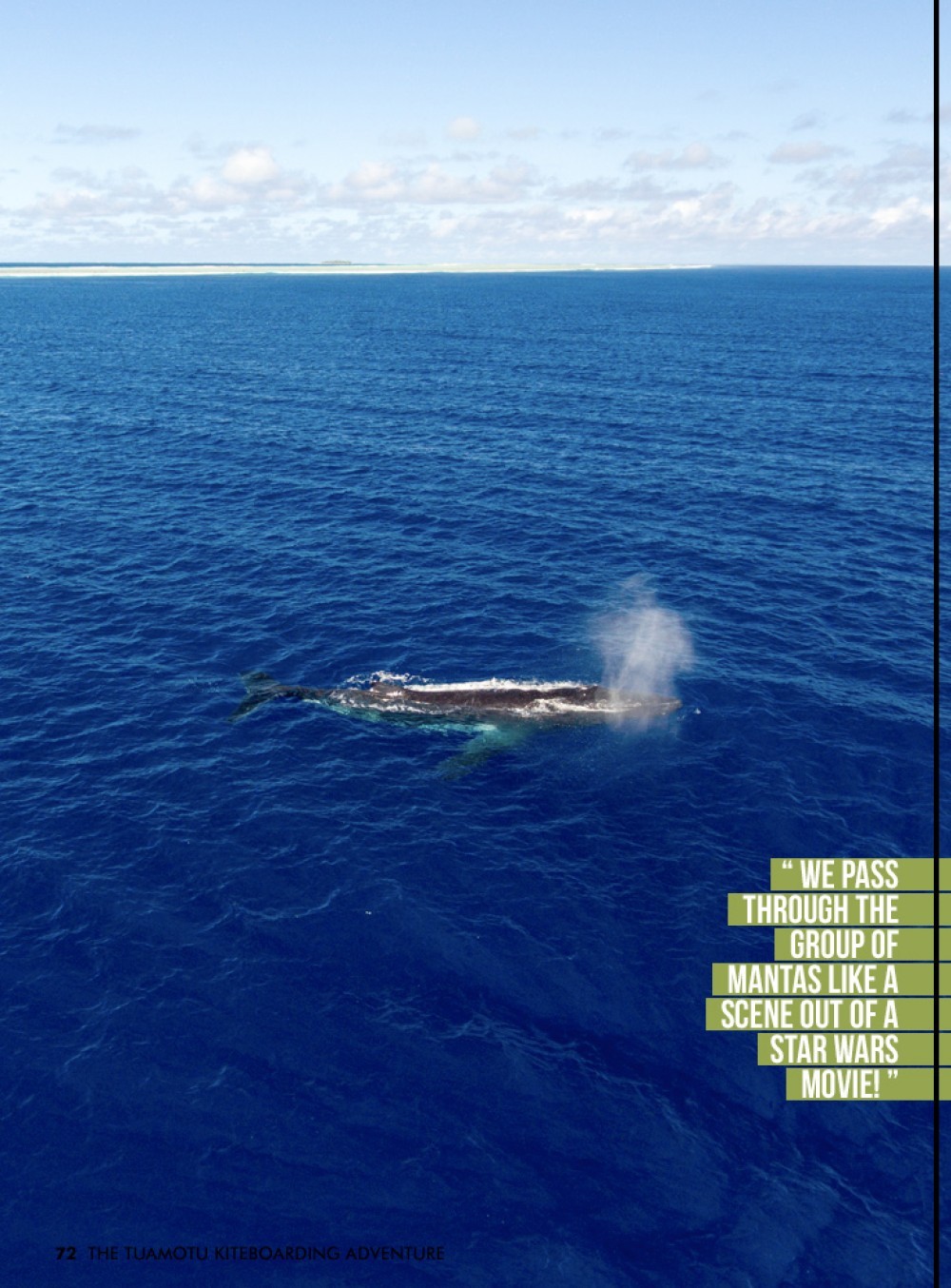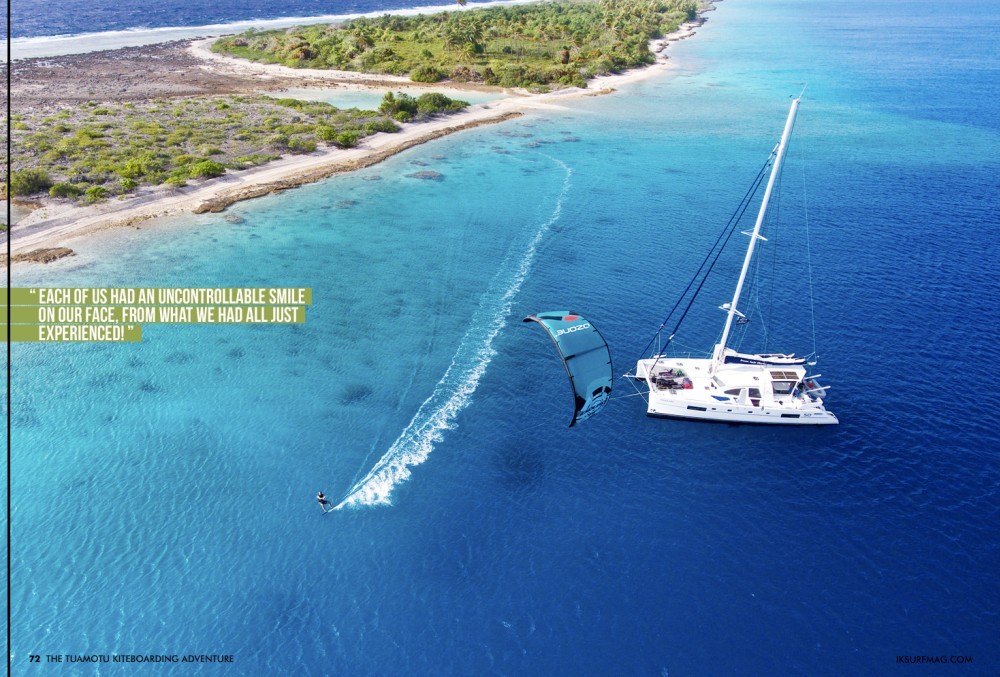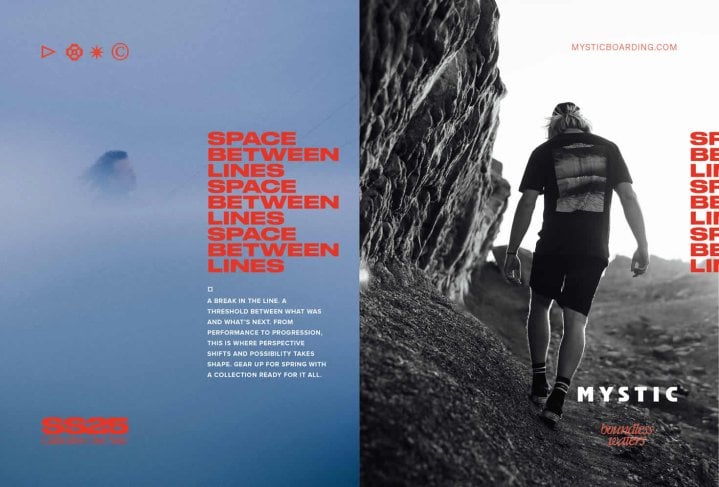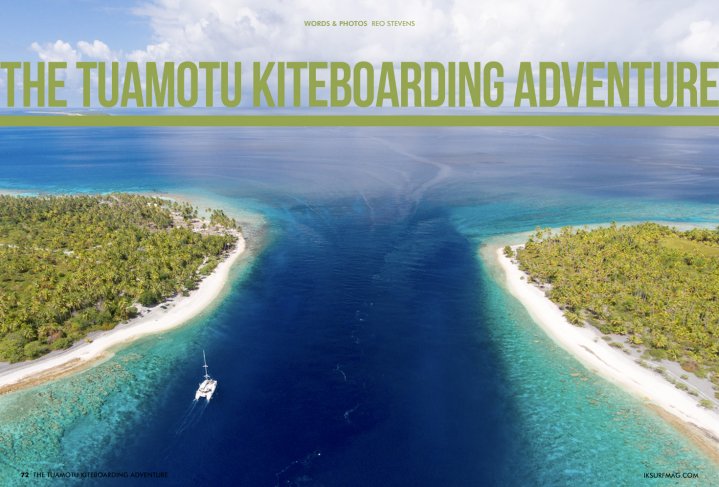
Tuamotu Kiteboarding Adventure
Issue 72 / Mon 10th Dec, 2018
Reo Stevens has been running adventure trips for a while now, and Tuamotu in the Pacific is one of his favourite locations. Join him and his friends as they discover some of the most pristine lagoons on the planet!
Through my years as a professional kiteboarder, I’ve seen so many people follow the trends, and head to convenient and overpopulated kiteboarding destinations. Year after year, these locations have been exhausted by the crowds, leaving the opportunity of that magical session with just you and your friends nearly impossible. I find that if you are willing to put in that “little extra” you’ll be able to find something so much more special and discover that “little extra” was worth it.
Over the past ten years, I’ve been exploring The Tuamotu Archipelago and found some of the most phenomenal kiteboarding spots I’d ever visited.
The Tuamotu Archipelagoes are a group of about 80 island and atolls, 300 miles North-East of Tahiti. It is a part of the governing body of French Polynesia, and it is the largest chain of atolls in the world. It also holds the two largest lagoons in the world; Fakarava and Rangiroa, which doesn’t have much aside from an endless cluster of coconut trees.
They base their economy on small amounts of agriculture, consisting of Copra (dried coconut kernels used to make oil) and vanilla beans, and if you can believe it, Rangiroa even grows grapes and produces a Rosé wine from them (leave it to the French!) There is also a strong presence of pearl production on a handful of atolls. A few atolls are dream destinations for recreational SCUBA diving, snorkelling and kiteboarding!
Challenges Of The Trip
Because of the lack of tourism in the area, there is a lack of accommodation. Far from the luxury resorts of Tahiti and Bora Bora, most accommodation options are limited to the local pensions (bed and breakfasts) which are usually at the reef passes and only catering to the diving tourist, leaving the reality of travelling there with the intention of kiteboarding nearly impossible.
It wasn’t until recently when I started the Reo Stevens Coaching Kitesurfing Adventures to the most beautiful and remote locations, that I could share what I had discovered, and learned over the years.
The logistics aren’t easy; the nearest charter boat is 300 miles away. The ability to stock fresh vegetables is a premium, and the Tuamotus are regarded as “extremely dangerous” for cruising boats, with many of the atolls being uncharted and littered with hazards that can quickly sink a boat, if you’re not paying attention.
How We Get There vs How You Get There
We are on night two of our three and a half-day crossing from the island of Raiatea towards the Tuamotu Archipelago; it’s 2 A.M, the mainsail is set at the 2nd reef, headsail out, with an apparent wind of 14 knots. The motors are off, and the air is silent and smells of salt. The boat is breezing along with the autopilot set, and the boat’s course over ground (COG) is at 60 degrees, maintaining an average speed of 7.2 knots (which is good for a sailing catamaran) I adapt better than expected to my assigned 12 A.M.- 3 A.M. watch.
The job’s requirements are simple; keep the boat on course and afloat by avoiding other ships, reefs, and possible rainsqualls that could dramatically increase the wind, all while maintaining the navigational instruments within a list of parameters set by the captain. Anything outside of that, wake the captain with no hesitation!
Over the years I have become accustomed to the “watch” job during crossings, but I don’t believe I’ll ever get used to being awake at night – I prefer to be sleeping and resting for the daytime activities.
Mostly, it’s a routine task that leaves you alone in the dark with nothing but your thoughts and imagination. However, being on a boat, in the middle of the sea during a crossing at night, you’ll discover that when the lights go out, and the darkness takes over is when there is the most to see.
Look up, and you’ll find that the density of stars is so thick, it can make the sky can appear almost alien. With no air or light pollution, the stars light up brighter and more vividly than you can imagine. Look down at either the bow or the stern and enter a trance while watching the phosphorescence light up as the hull of the boat stirs the water.
I am alone with just my thoughts until the next crewmember awakes to relieve me from my shift. There’s another day and a half until of this routine until we reach our destination where we will meet the first round of guests for the season.
The incoming guests have a much easier time getting to the Tuamotus by joining us from Tahiti on a comfortable 45-minute flight (compared to our three and a half day journey) for ten days of kiting, SUPing, spearfishing and overall relaxation. Filled with delicious food and memorable moments, in one of the few places in the world you can experience all of that surrounded by a minimal amount of people.
The Remoteness, And What That Means
There’s not much in the form of connectivity in this part of the world, and with what little that is offered is unreliable (or slow enough) to only frustrate you, but really its waste of time!
We do have a satellite phone and texting capabilities for weather updates, keeping up with families and emergencies, but they are there for just that. The typical day-to-day fast connection is not an option. It’s a bittersweet taste, but separating from the rest of the world allows you to reconnect to things that matter most at any point in time; the people and world around you.
I will not lie to you; connectivity withdrawals are real! It’s a concept you laugh at, but you reach for a phone in your pocket every ten minutes, only to realise that does not do much more than snap a photo or play a song (don’t forget to download your Spotify list before coming!). However, the bitter turns to sweet after a few days, when the need addiction subsides, and you relax and settle into your new surroundings. Then you truly experience what this pristine location has to offer without any distractions.
Special Moments That Only Happen On A Boat!
The thing about atolls is, it’s always offshore somewhere. Even with variable wind directions, all you need to do to find that perfect kite spot is to see an area with a big enough of a gap in the endless palm trees that the wind can freely pass over the land to find your next personal kite spot.
Most of these “kite spots” don’t have a beach or even a proper launch area; however, that’s not a problem when you’re living on a launch pad! Where ever you go on the boat, you can quickly launch and land from the stern.
Once your kite session is over, you can head back to the anchored boat, park your kite off the stern and sit back in the shade, recharging your body, while your kite is waiting for your next session. Can it get any better than that? Well, it kind of can! During our trips, I like to say; our "Plan B is most peoples Plan A”. It doesn’t matter where you go, even the most reliable kite destinations have their down days, and there’s always a chance that the weather doesn’t cooperate. It would be nice, but not every day is filled with 20knts. So what do we do? We make sure other options are just as amazing!
In my opinion, a perfect ten-day trip in the Tuamotus consists of about five-six days of wind and the rest with perfect glassy conditions. What makes the Tuamotus so unique isn’t just the kiting conditions, but also what is offered underneath in the clear blue waters.
One highlight of our last trip happened on a light wind morning while everyone was relaxing after breakfast. We were anchored near one of the reef passes when someone noticed some action going on underwater in the distance. The water was stirring with what looked like a group of shark fins.
Grabbing the binoculars, and having a closer inspection the fins were not from sharks, but rather, manta rays! The Captain’s enthusiasm quickly turned the quiet lazy morning into a fast-paced frantic, as everyone promptly scrambled to grab their snorkeling gear. Swimming with manta rays has always been a goal of mine; I have swum with sharks and stingrays but never manta rays! I was just as excited as the rest of the group to cross “swimming with manta rays” off my bucket list.
We loaded the dingy up with as many people as we could fit, while still keeping it afloat, and slowly motored towards them. As we approached the rays, we noticed that there was a lot more than we had initially thought. There were about 15 rays, each at least with a 6ft (2m) wingspan, doing laps in the pass feeding in the outgoing current. Mantas are filter feeders, and feed on plankton, small fish and crustaceans and are harmless to humans. We continued to slowly motor up, a little closer to them and prepared to jump into the water for a swim.
As the whitewater bubbles clear from the front of my mask, a deep, dark and breathtaking blue fills my vision. The current, too strong to swim against, took the group quickly toward the manta rays; staring straight ahead, with my eye wide open in anticipation of what’s coming I see the large “hovercrafts” appear in the distance.
With the current taking us quickly in one direction, and the mantas swimming in the other, we pass through the group of mantas like a scene out of a Star Wars movie! Everyone froze and watched in awe as these large majestic creatures swam through the group just a few feet away from each of us. So just like that, and just as quickly as they came into view, they breezed past us unaffected by our presence and disappeared into the distance up current.
“WOW! That was amazing! Let’s do it again!”
“OK!”
We gathered up the group and climbed back into the dingy to motor back up current to do it again. We repeated this for a few rounds. As we slowly motored back to the boat each of us had an uncontrollable smile on our face, from what we had all just experienced!
Parting Ways
After a solid 10-days of kiting, swimming with manta rays, spear fishing, beach bonfires and tons of laughs, it’s time to part ways and begins the journey home. The guests, once again, with a quick 45-minute flight back to Tahiti before their flights to each of their homes, and us with what should be a beautiful two day downwind sail. However, the forecast has other plans for the crew and myself. 40 knots and 15ft swell are now forecasted to hit a few hours after we’re scheduled to begin the journey back.
After all the smiles and hugs goodbye, we part ways battening down the hatches to prepare for what will be a not so pleasant sail back to Raiatea, but rather two days of no sleep, broken dishes and constant state of being cold, wet and salty. Is it too late to jump ship and fly back with the guest?
For more info on how you can experience this magical place yourself as well check out https://www.reostevenscoaching.com
Videos
By Reo Stevens


